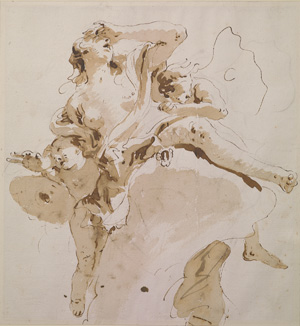Around 1730, Giambattista Tiepolo took up Punchinello. Halfway through his thirties, he knew all too well the follies of youth and age, much like the buffoon in Italian puppet shows. And his countrymen loved them all—the puppets, the show, and the follies.
His Punchinello catered happily to their taste for moral judgments and for comedy, and in no time he found himself their go-to artist. He painted the ceilings of palaces and churches not just in Venice, but across Italy and Europe. Still, his work is just half the story of “Spirit and Invention” at the Morgan Library. Drawings and occasional oil studies by Giambattista and Domenico Tiepolo trace the course of a dynasty. Can you tell father and son apart? That is the challenge and temptation, through January 28—and I work this together with a past review of Tiepolo as a longer review and my latest upload.
The older Tiepolo died in 1770, but his spirit lived on, and so did his projects. He was still a fairly new father in 1730, and his son joined his workshop as soon as the boy was able—and inherited it as well, with commissions and assistants to spare. Late in life, Domenico turned back to Punchinello as well, with new stories to tell. His clowns encounter an elephant, ride an ass in a comic ritual procession, and enter the ebb and flow of Venetian life. They go to the barbers and watch a carpenter and glass-blower in their busy workshops. At last, too, Punchinello is laid to rest. Had the son put his father’s legacy to rest at last as well?
Giambattista Tiepolo all but reversed the old aphorism nothing in excess. (He might have related to another line often attributed to Terence, the Roman playwright, nothing human is alien to me.) He could not stop with one Punchinello when he could cover a sheet with at least ten of them, united in folly and in their conical hats. He may not tell them apart or give them all that much to do, but they are only puppets, after all. For him, too, much the same cupids accompany Greek gods and heavenly angels. They are all, as the titles of many a ceiling work have it, caught up in a tale of triumph and ascent.
New York has had no shortage of Tiepolo, just as Tiepolo had no shortage of ceilings and clowns. It has seen Giambattista Tiepolo in retrospective, Tiepolo in Milan, Domenico Tiepolo, and late Baroque Italian drawings—and it hardly hurts that the Morgan Library owns hundreds of drawings by both father and son. Allow me then, to direct you to past reviews for more. As I wrote back then, Veronese and others in his native Venice composed a world of gods, beyond ordinary human perception. Tiepolo has taken his place wholly in this world, while ennobling it. The wealthy institutions that he served, the church and nobility, saw themselves as similarly fervid and triumphant.
This show adds the restriction to father and son, together and apart. It also has room that a retrospective did not for the years that got things going. Giambattista when young cared as much as any Renaissance model for anatomy, and the Morgan opens with heroic males nudes in parallel strokes of black chalk that define every muscle. Even as Tiepolo came to rely far more on ink washes, an undercurrent of classicism remains. He also cared as much as his predecessors for foreshortening, only directed to new ends. A sketch for a ceiling painting shows its framing walls as well, pointing perilously upward.
In another commission, the heavens take on greater motion as one ascends the stairs below. Yet times have changed, and architecture for figures in flight should make you think of something far lighter in weight, period rooms at the Frick Collection for François Boucher, a close contemporary. Times have changed, too, in bringing things back to earth for contemporary life and comedy. Neither Tiepolo can disentangle the two.  For Giambattista, portraits and caricatures are much alike. For Domenico, a monkey looks like a friendly devil.
For Giambattista, portraits and caricatures are much alike. For Domenico, a monkey looks like a friendly devil.
The son does bring changes. Sketches by the father close in on arms raised and legs thrust out. Figures gesticulate, at rest on a cloud, while the younger artist focuses on floating and flight. Washes intensify, poses look more solid, and stage sets, like those for his late Punchinello, have a clear ground. His belief in human folly looks ahead to the next century and Francisco de Goya. All the same, they crossed Europe together, and the finished ceilings were a product of both.
Domenico never could bury his father’s legacy, because he saw no reason to try. He just happened to have thirty-four more years to discover where that leads. Where he cannot, he just changes the subject. Their shared ceilings carry out Giambattista’s design—and then come only scenes from life, dancing dogs, and the puppet show. In Punchinello Carried Off by an Eagle, the actors ride a boat that the father had used for the Holy Family, but nothing lasts forever, not even the human comedy. With Punchinello’s burial, was Domenico anticipating his own death instead?
Read more, now in a feature-length article on this site.
